How To Choose a PWC Boat Cover
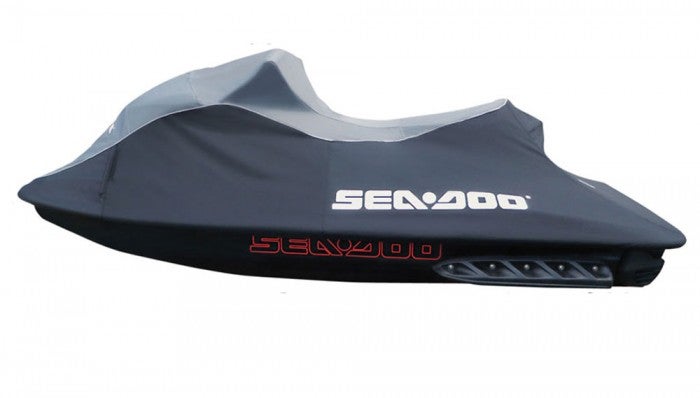
Protect your craft against Mother Nature
It’s one of the least glamorous items you’ll consider for your PWC, but a good cover is one of the best investments you can make for your craft’s long-term looks and condition. Why? Mother Nature is one cruel mama. Leave your craft uncovered and her harsh UV rays will fade and weather your prized possession in no time. Her rains and storms will only add insult to injury.
A cover can prevent all that, but it’s not as simple as buying the cheapest alternative available and tossing it atop your ride. Opt for a bargain all-purpose cover and you may protect the outside of your craft, but find its non-breathable fabric turns the environment inside into a welcome home for mildew and condensation. Cheap covers also won’t hold up long term to on-the-road tow duty. Seams will rip and flapping material can damage your craft’s pristine finish.
Covers are available from all of the major manufacturers as well as numerous catalog and Internet stores. Here’s what to consider:
Materials
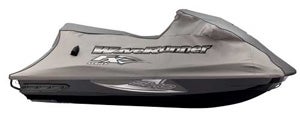 PWC manufacturers all offer covers for their products, which are designed to fit precisely.
PWC manufacturers all offer covers for their products, which are designed to fit precisely.Look for a breathable fabric that will allow air to circulate and prevent moisture from building up below. UV and water-repellant finishes will prevent rapid fading and weakening from sun exposure, as well as shed rain and morning dew before it soaks into the material.
As you might expect, price increases in direct proportion to quality in most cases. At minimum, look for a cotton/polyester blend; it’s strong, breathable, and up to the rigors of trailering. Polyester is exceptionally strong, water-repellant, and breathable. Acrylic-covered polyester fibers, like the trademark Sunbrella fabrics, are the ultimate. They’re solution dyed to resist fading, naturally somewhat water resistant thanks to the fabric’s weave, breathable, and yet strong.
Construction
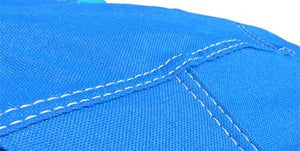 Folded seams with no exposed fabric edges are a sign of good construction.
Folded seams with no exposed fabric edges are a sign of good construction.Ideally, seams should be four-ply folded for durability and strength; avoid any exposed fabric edges. Weather-resistant, anti-wicking thread should be double-stitched. Any areas that will see excessive wear from below should be reinforced with sewn-in panels. A draw cord, or possibly even a webbed strap with a buckle, should reside within the perimeter hem to tighten and secure the cover to the boat. Further tie-down security to the trailer comes from tie-down loops around the perimeter.
Fit
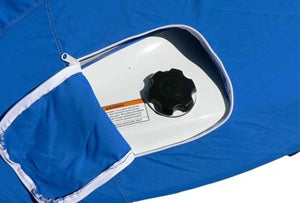 A zippered gas flap is a convenient feature.
A zippered gas flap is a convenient feature.Nothing’s better than a custom fit tailored to the every contour of the boat below. OEM covers are ideal in this regard. Local canvas shops can also create custom covers to fit with precision. Semi-custom covers may be cheaper, however; typically they’re sized to a boat’s general length and width.
Extra touches? Look for a zippered gas-cap access flap to allow you to fill your boat without removing the cover.
Color
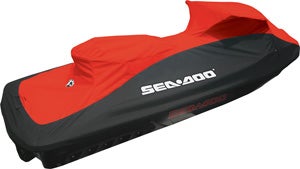 Bright colors will fade more, but are more resistant to UV rays.
Bright colors will fade more, but are more resistant to UV rays.Colors are cool, but keep in mind the shade you buy today may not be the hue you’ll have in a few year’s time. Lighter colors are typically best. They fade less than deep, rich shades, and won’t absorb as much heat throughout the day. On the flip side, however, darker colors are more resistant to UV rays, and typically last longer. They also won’t show stains like a lighter color.
Think hot, dry climates are the worst for fading? Humid climates are actually the worst; they cause an oxygenation process that fades color more rapidly.
Care
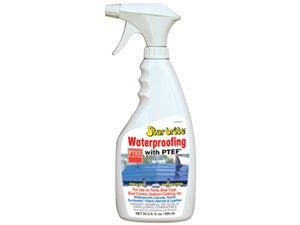 Regularly cleaning and protecting your PWC cover can add years to its life.
Regularly cleaning and protecting your PWC cover can add years to its life.Don’t just buy a cover and forget it. Spray off simple debris, like bird droppings, leaves, and dirt with a garden hose. Use a mild soap, like Ivory, and a soft brush for more serious stains, rinsing thoroughly when complete. Serious stains? Try mixing a ½ cup of bleach and ¼ cup mild soap in a gallon of water, and gently brushing.
Notice water no longer beads on the cover’s surface? Refresh its water repellency with a spray treatment like StarBrite Waterproofing & Fabric Treatment with PTEF ($20 for 22-ounce spray, http://www.starbrite.com/).
Related Reading
Safe Trailering for Personal Watercraft
How To Tie Secure Knots for Your PWC
Fuel-Saving Tips for Personal Watercraft
How to Repair Personal Watercraft Hull Damage
Get PersonalWatercraft.com in your Inbox!
Like PersonalWatercraft.com on Facebook
Comments
Most Popular

2025 Yamaha JetBlaster PRO 2-Up Review

Remembering the Sea-Doo XP

2024 Kawasaki Jet Ski STX 160X Review

Whatever Happened to the Wetbike?

2025 Yamaha JetBlaster Review






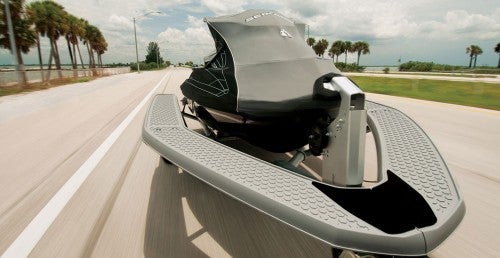






 Your Privacy Choices
Your Privacy Choices